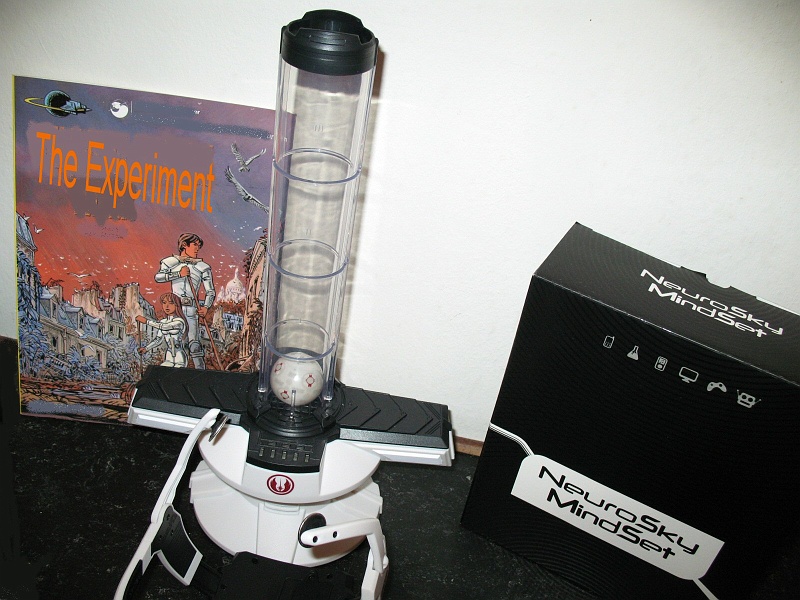Experiments with the NeuroSky ToolKit.
April 28th 2010 - by Simon Laub - Email: SimonLaub.mail@gmail.comInexpensive headsets that detect brainsignals allow you to play games using only your mind.
In the Force Trainer game your aim is to focus. Achieve the right brain rhythm and a fan switches
on,
lifting the ball inside the tube.
// For the original 2010 (Flash designed) web-page, see here //

Electroencephalography (EEG),
the technique that enables such brain controlled games,
was invented early
in the 20th century. It measures the electrical activity of neurons within
the brain via a set of electrodes affixed to the scalp.
According to Wikipedia:
The electric potentials generated by single neurons are far too small to be picked by EEG.
EEG activity therefore always reflects the summation of the synchronous activity of thousands,
or millions, of neurons that have similar spatial orientation, radial to the scalp.
Discovers ''The Brain'' (Spring 2010) issue digs a little deeper, in an article about
''Games that detect brain signals'':
NeuroSkys hardware was developed by Burford Furman [1],
and students, of San Jose State University.
NeuroSkys breakthrough was its ability to read brainwaves,
without the
electrically conductive gels and the clunky,
unattractive (and expensive) headset that laboratory EEG requires.
Neuroscientist Majid Fotuhi [2] collaborated on developing the toy:
''The games software is able to decode a players
state of mind because
the ''concentration'' and ''meditation'' electrical states are
broadly distinguished from
each other, and those
states influence the entire front of the brain.
The strength and
distinctiveness of the two signals mean that the toy can employ
just one forehead EEG sensor
rather than the multiple electrodes used
in the lab''.
Still, the headset might seem a little awkward, as it need a second skin contact, either on the ear
or behind it,
to help filter out background signals.
And certainly, more sensitive headsets will someday allow for more elaborate games.
Let the games begin.
The setup is very simple. A ball in a plastic tube with a fan underneath.If the headset registers the right brain patterns, the fan moves and elevates the ball.
Andrew Moseman (from Discover) reported that he
''succeed only when I focus on the ball to the point
of going nearly crossed-eyed''.
And yes, you really, really have to focus to move that ball.
Some have even suggested that the equipment is actually picking up on muscle tensions, not brain waves.
Nevertheless, everyone seems to agree that it is an awesome moment, when the ball actually levitates...



Download Forcetrainer videos in the wmv format: Ex1, Ex2 and Ex3.
The next steps.
Where this is all going, obviously, no one knows.E.g. Some think it might even be possible to decode words from EEG signals..?
I came across this one:
DARPA has budgeted $4 million in 2009 to investigate technologies to enable soldiers on the battlefield
to communicate via computer-mediated telepathy [3]. Could it be possible to decode
EEG signals for a word? I.e. ''Before being vocalized, speech exists as word-specific
neural signals in the mind. Darpa wants to develop technology that would detect these signals of ''pre-speech'',
analyze them, and then transmit the statement to an intended interlocutor [4].
(And) There might be even bolder projects out there!
Certainly, only our imagination sets the limit for what is possible.
As Arthur C. Clarke would have agreed [5].
Clearly, much more will follow!